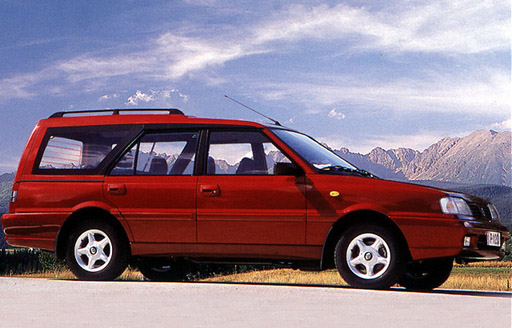 Detriment, that the model, so much awaited by the Polish market, was developed only after FSO was taken over by the Koreans. The offer of the Warsaw factory was at least ten years late. How much it was needed can be seen in the classic Polonaises with a hatchback body, equipped with various types of superstructures. Huge interest, which the Polonez Kombi enjoyed is a confirmation, that also in this case the ratio of price to utility is very favorable. Anyway, the performance of the Polonaise is at a decent level, although the whole car from the construction side must be considered obsolete. The estate model was developed from the Atu version and launched in August 1999 r. The classic sedan was adapted to the installation of a plastic superstructure, which greatly facilitated the construction work. The whole thing looks neat, although some details can be seen, it's just an adaptation. The Polonez Kombi was shown at various exhibitions as a concept vehicle and its angular design has always been striking. When sharp lines came in fashion, angular body does not raise such objections.
Detriment, that the model, so much awaited by the Polish market, was developed only after FSO was taken over by the Koreans. The offer of the Warsaw factory was at least ten years late. How much it was needed can be seen in the classic Polonaises with a hatchback body, equipped with various types of superstructures. Huge interest, which the Polonez Kombi enjoyed is a confirmation, that also in this case the ratio of price to utility is very favorable. Anyway, the performance of the Polonaise is at a decent level, although the whole car from the construction side must be considered obsolete. The estate model was developed from the Atu version and launched in August 1999 r. The classic sedan was adapted to the installation of a plastic superstructure, which greatly facilitated the construction work. The whole thing looks neat, although some details can be seen, it's just an adaptation. The Polonez Kombi was shown at various exhibitions as a concept vehicle and its angular design has always been striking. When sharp lines came in fashion, angular body does not raise such objections.
In the Polonaise, the back cover is almost vertical, so the use of the space above the shelf can be very effective. The trunk was covered with a flexible mask (roulette), rolled up. The flat floor of the trunk is placed at the height of the loading edge, but there are no slats on it, make it easier to move items, l handles for attaching luggage. Lockers are also missing. The wheel arches go quite deep into the boot, but they are low. The asymmetrically divided sofa has fold-out seats. With the backrests folded down, the extra space is completely flat. There is no upholstery on the backrests on the trunk side. There are rebars on the roof. The drive unit cannot be selected in the Polonaise, because only one motor is installed.
